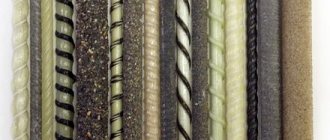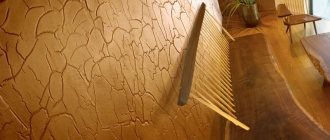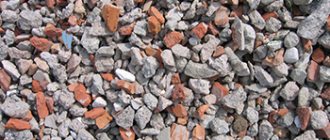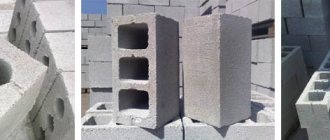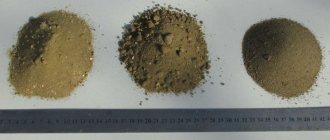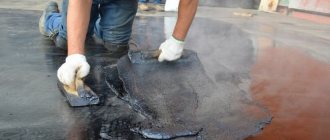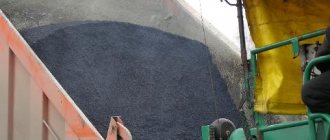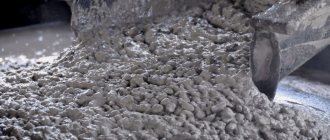The request "Skudel" is redirected here. A separate article should be created on this topic.
This term has other meanings, see Clay (meanings).
The request for "Clay" is redirected here; see also other meanings.
| Clay | |
| Quaternary clays (Estonia) | |
| Minerals | Clay minerals |
| Group | Sedimentary rocks |
| Physical properties | |
| Color | different |
| Radioactivity | no GRapi |
| Electrical conductivity | No |
| Melting temperature | >1700 °C |
| Media files on Wikimedia Commons | |
Clay extracted from the ground during the construction of the Teatralnaya metro station of the St. Petersburg metro
Clay
- a fine-grained sedimentary rock, dust-like when dry, plastic when moistened.
Clay consists of one or more minerals of the kaolinite group (derived from the name of the locality Kaolin in China), montmorillonite or other layered aluminosilicates (clay minerals), but may also contain sand and carbonate particles. Typically, the rock-forming mineral in clay is kaolinite (Al₄[Si₄O₁₀](OH)₈), its composition: 47% (by weight) silicon (IV) oxide (SiO2), 39% aluminum oxide (Al2O3) and 14% water ( H2O).[ source not specified 51 days
]
Al2O3 and SiO2 - make up a significant part of the chemical composition of clays of yellow, brown, blue, green, purple and even black colors. The color is due to impurities of ions - chromophores. [ source not specified 51 days
]
Properties of clays: plasticity, fire and air shrinkage, fire resistance, sintering, color of ceramic shards, viscosity, shrinkage, porosity, swelling, dispersion. Clay is the most stable waterproofing material - waterproofness is one of its qualities. Due to this, clay soil is the most stable type of soil developed in wastelands and wastelands. The development of any root plant system in clay deposits is impossible. The water impermeability of clay is useful for preserving the quality of groundwater - a significant part of high-quality artesian springs lies between clay layers. [ source not specified 51 days
]
What is clay?
Geological science has been studying rocks for quite some time.
Scientists have found that clay, not contaminated with foreign impurities, consists of small particles. The diameter of the dust does not exceed 0.01 mm. These are particles that belong to a specific group of minerals. It is no coincidence that the use of clay has become widespread. Rock is an intricate chemical compound containing water, silicon and aluminum. Clays change their properties under the influence of liquid. Depending on the amount of water that is added to the rock particles, a plastic mass or lime may be formed. Liquid with added clay has a high degree of viscosity. This property is widely used in the construction and repair industries.
Description
The material contains one or more minerals of the kaolinite group.
The base may be a mineral of the montmorillonite group and other layered aluminosilicates, which are also called clay minerals. May contain carbonate and sand particles. The rock-forming mineral is kaolinite, which consists of silicon oxide in a volume of 47%, aluminum oxide - 39%, and water - 14%. A significant part of the chemical composition of yellow clay is Al2O3 and SiO2. The material can have the following colors:
- green;
- blue;
- brown;
- black;
- lilac.
The color is due to ion impurities, which are chromophores.
CLAY CREAM
Everyone knows that clay masks smooth out wrinkles, rejuvenate the skin and give it a fresh look. They are more effective than all others.
For such masks, the clay is usually diluted to the thickness of sour cream, and then a thin layer is applied to the cheeks, forehead and nose. To prevent the clay from slipping, you can cover your face with a piece of gauze and press lightly. If you also wet it, the mask will dry a little slower, which means its effect will be greater. You need to remove this mask after an hour and a half. Then immediately wipe your face with warm water.
The most popular clay masks are masks made from a mixture of clay powder and cucumber juice in a 1:2 ratio. This mask is kept on the face for about 20 minutes, after which it is washed off with warm water and lubricated the skin with moisturizer. You can prepare clay masks using the juices of other vegetables, fruits and berries - this will also give good results. Tomatoes, lemon and cranberries are especially suitable for these purposes.
Clay cream is clay brought to a creamy state. At the same time, it is not at all necessary to add oil or anything else to it, since the clay is effective on its own.
With the help of clay, you can whiten the skin of your hands and feet; you just need to knead the clay in your hands for about an hour or knead it with your feet, fashion something out of it, and you will notice how snow-white and renewed your skin will become. By trampling liquid clay, you can get rid of even the most stubborn calluses.
Clay cream will also help against freckles. It is impossible to prevent the appearance of these yellowish-brown age spots, which most often appear in the spring and summer, but it is possible to sharply reduce their number. If you wipe your skin with clay cream in the morning and evening, you will notice how small freckles completely disappear, and large ones become paler.
Cucumber has been a folk remedy for freckles for quite a long time. A cucumber soaked in clay water was rubbed on the face twice a day.
Using clay, you can take hygienic and therapeutic baths. Hygienic baths, the purpose of which is to cleanse the skin of excretory products and impurities, are carried out, as a rule, once or twice a week. The duration of this procedure is about half an hour. They stimulate the function of the sebaceous and sweat glands, help cleanse and strengthen the body.
https://www.youtube.com/watch?v=ytpressru
This bath is prepared quite simply: pour colored clay powder into the filled bath and stir thoroughly. You need to add enough clay so that the water becomes slightly cloudy (about 15 spoons), then immerse yourself in this bath, and after taking it, rinse with cool water in the shower without using lotions and soap.
Previously, baths were taken in a rather unique way. This is how the promoter of clay baths, the healer Adolf Just, writes about this: “They dug a very large round hole in the ground and filled it with water and good clay. Clay and water were mixed to form a light liquid mass. The patient was placed in it up to his neck, and he sat in this viscous mass for several hours.”
Therapeutic baths are usually prescribed by the attending physician and are carried out in specialized medical institutions. But some types of medicinal baths can be prepared at home. For example, a clay-mustard bath is used for colds and various types of infectious skin diseases, and a starch-clay bath is used to relieve irritation and itching.
Clay water baths are not only full baths, when the whole body is immersed in clay water, but also partial, incomplete baths. They are slightly different from the previous ones, since only the hands or soles of the feet are immersed. The limbs are placed in a very liquid clay solution for half an hour, previously kept in the sun for some time, and rubbed thoroughly. Such baths are used to improve the skin on the hands and feet, as well as to relax after a hard day.
Baths, perhaps, include rubbing with clay, which is carried out right before bathing. Clay or clay water is applied to the skin using a cotton swab and allowed to absorb a little. Then wash off the clay in the shower and again rub all sore spots with a cotton swab dipped in a weak clay solution.
Clay oil is used both as a cosmetic and as a medicinal product. They treat cuts and bruises, cleanse the skin of pimples and acne. Clay oil is prepared as follows: clay powder is stirred in any oil (even butter) to the consistency of sour cream, and then applied to the skin or sore spot.
Clay and food.
Nobody likes to be treated. Especially children, who cannot be forced at gunpoint to take medicine. But parents can always find an approach to their child. To do this, you can use, for example, the following trick. Take the most common briquette ice cream. Chop it into small pieces and place it in a saucer. And sprinkle clay powder and a small amount of chocolate on top.
Everyone's favorite popsicle was invented by hereditary confectioner Christian Nelson in 1922. In his invention, he tried to combine two child passions: chocolate and ice cream.
Exactly the same deception can be carried out by adding clay to cooked dishes. In this way, you will quietly prevent many diseases, cleanse the bodies of family members from harmful substances and toxins, and also help those who need it to heal. Where exactly and how much clay water or powder to add will be discussed further.
So, over the summer you have stocked up on enough clay, but you don’t know how to get your family to start taking it. Try giving them dried fruit cookies.
These cookies are easy to prepare. Five slices of dry apples, five slices of dry pears or any other fruit are passed through a meat grinder and mixed with one teaspoon of clay powder. Then carrots and beets are grated. You also need very little of them - 2 tablespoons each. All ingredients are mixed and seasoned with a spoonful of jam or preserves.
It perfectly complements powdered clay and all kinds of porridges: semolina, rice, millet, pearl barley. If you thoroughly stir a teaspoon of clay into them, no one will feel it. By the way, in this case, porridge can be seasoned with honey - it is much better and healthier than regular sugar.
Probably nowhere else do they care about their health as much as in China. The Chinese are very careful about everything they eat. Perhaps this is why they were among the first to believe that a healthy dish is a dish that contains everything in its natural form.
Clay powder can also be an inconspicuous addition to dishes that are seasoned with various spices. For example, for pilaf, meat, and so on. You can even immediately add clay to the container in which you store spices and mix it with them. This is much more convenient, since you certainly won’t forget to add healing clay to the dish. In addition, clay, like spices, should be added to dishes 5 minutes before the end of cooking.
As for drinks that can be combined with clay water, this includes all types of wines, dairy drinks (kefir, fermented baked milk), cold compotes, and natural juices. Such an additive will not harm cocktails either. The only condition is that it should be introduced into them last, and not at the very beginning, so that the clay does not have time to settle.
https://www.youtube.com/watch?v=ytaboutru
In general, clay is not noticeable as an additive in potato cake. You just need to combine it with one tablespoon of sugar and two tablespoons of cocoa and pour in warm milk. Then pass the crumbly cookies through a meat grinder and pour them into the prepared mass. Add a little butter and mix thoroughly.
Clay and peanut scrap will be a great addition. To prepare it you will need a glass of sugar, a little butter and a little water, possibly clay water. All this should be placed on the fire and, stirring, bring to a boil. Then remove, cool and add a glass of unsalted peanuts, and with it one tablespoon of clay powder. Pour the resulting mass into the mold and, after finally cooling, chop into pieces.
Clay can be used not only as a food additive, but also as a substance that can increase the shelf life of many food products. For example, not everyone knows that if clay powder is placed on a plate in the refrigerator for two hours, then all the unpleasant odors in it will disappear. And if root vegetables such as carrots, beets, radishes and potatoes are dipped in a clay mash for a few seconds and then dried, they will remain intact all winter and will not rot.
Contraindications.
Oddly enough, clay is perhaps the only drug that has no contraindications for use. It is not harmful, although it can cause unpleasant reactions (with sensitive skin) if you immediately start taking it in large quantities. It is best to start treatment with water with the addition of a small amount of clay, and when the body gets used to it, begin to increase the dose, bringing it up to consuming two tablespoons of powder per day.
In cases where taking clay is accompanied by pain, you just need to soak it in the sun for several hours, then the body will accept it more easily. You should drink clay water not in one gulp, but in small sips. Pain may occur after taking clay if you immediately eat a heavy meal - but this is most likely your fault.
What is clay and clay therapy
To relieve or get rid of joint pain, the first thing people do is rush to the pharmacy to buy medications. But instead of drugs at the same pharmacy, it is better to purchase blue clay powder and try to eliminate the problem using natural methods.
A fossil of this color is actively used in cosmetology, but few people know about the miracles that blue clay works for sore joints. It helps relieve swelling, resolves inflammation and relieves pain. And all thanks to the rich mineral composition, as well as the presence of radium particles in it. The amount of this radioactive element in clay is minimal, but enough to benefit sore joints.
To begin the treatment, you will need blue clay powder, water, a bandage and a woolen cloth. Dilute a small amount of clay with water to form plasticine and let it sit for five to ten minutes. Then form a cake from the resulting mass and apply it to the sore spot, secure it with a bandage and insulate it with wool.
Keep the compress for a couple of hours. An indicator that the clay has given up all its properties will be heating or drying of the compress. This means that you need to replace the used material with fresh material and continue to withstand the required time. Used clay cannot be reused; new powder is needed for each cake.
Ingesting so-called clay water will help speed up treatment. It is prepared very simply: dilute one teaspoon of powder in a glass of cold boiled water and leave in the sun for hours. After this, take two teaspoons of the solution orally every hour.
White clay (kaolin, Chinese clay) is a traditional raw material component in the manufacture of cosmetics. Purity, whiteness, non-abrasive nature and harmlessness make this mineral a valuable ingredient in cosmetology. In pharmacy it is used in the form of powders, ointments, pastes, as well as for diaper rash and burns, and is part of cleansing masks. An indication for the use of clay may be acne. In addition, clay for medicinal purposes:
- cleanses the epidermis;
- has an antiseptic and regenerating surface effect;
- stimulates the body's defenses, having a special effect on the epidermis exposed to environmental pollution;
- saturates the epidermis with minerals;
- prevents the spread of germs due to its ability to absorb toxins and contaminants;
- has enveloping and adsorbing properties;
- facilitates cellular regeneration by stimulating metabolism.
It has a structure similar to green clay, but differs from it in the presence of trace elements. It has a pH = 5 and can therefore be used even for sensitive skin.
The healing properties of white clay are due to a high percentage of aluminum and silicon with an admixture of magnesium and calcium silicates. Used in masks, milk and shampoos for dry hair and in children's cosmetics.
Medicinal blue clay is mined in the Rhodope Mountains (Bulgaria). It is a powdery mass with pH = 7.3, contains a large amount of copper and chromium, salts, which give it a bluish tint. Recommended in its pure form (when mixed with water) for use as masks for hair, skin, face and body.
When deciding which cosmetic clay to choose, keep in mind that blue clay softens and tones the skin, clears acne, whitens, smoothes wrinkles, has a beneficial effect on oily hair, and has anti-cellulite, antibacterial and anti-stress effects. It has a good effect on dehydrated, dull, atopic skin.
Kaolin is most often used for cosmetic purposes.
Clay is everywhere, it is very easy to recognize, it is thin and dense. It can be found in places where the earth cracks: in quarries, near brick factories. Even in the garden, sometimes it is enough to dig one meter deep into the ground to find good clay. For cosmetic purposes and internal use, clay should only be purchased at a pharmacy.
Knowing which clay is medicinal, you need to decide for what purpose it can be used. For external use, the most preferred one, which has the best healing properties, is clay suitable for modeling. It is used in the production of bricks and ceramic products. The purer it is, the stronger the effect.
For external use, in cases of urgent treatment, and also if it is impossible to immediately obtain the necessary clay, you can use soil similar to it (loam). The loam must be clean. But it is still more advisable to use clay, since it has a stronger healing effect. Any clay mined in an ecologically unfavorable area must be tested for radioactivity.
The easiest way to prepare clay is as follows. Take good clay and lay it out to dry in the sun. If the clay is not dried enough, it will not dissolve easily in water. If there is not enough sun, then you should place the clay near the stove, heater or any source of heat or light.
Before using clay, clean it of various particles, pebbles, roots and other foreign matter. Pour the clay into a basin or other enameled, wooden or fired clay vessel. Dishes with chipped enamel will not work.
Fill the clay with fresh, clean water until it is completely covered. Let it sit for several hours so that the clay absorbs moisture, stir, and crush hard lumps with your hands or a wooden spatula. You cannot use a metal tool - it can adversely affect the prepared mass. It should be homogeneous in composition, without lumps, and should resemble mastic prepared by craftsmen for modeling.
This mass is ready for use. If necessary, slightly dilute the solution with water so that the mass is at the desired consistency, always ready for use. This way it can be stored indefinitely.
Properties of clays
The properties of any rock depend entirely on its composition. Clay is no exception. The size of the constituent particles also matters. When mixed with water, the rock can form a viscous dough. This property is widely used in various spheres of life. Clay swells in water.
Thanks to this, it can be used very sparingly. In its raw form, clay dough can retain absolutely any shape. Nothing can be changed after it has hardened. And so that the product can be preserved for a long time, it is fired. When exposed to high temperatures, clay becomes even stronger and more durable.
If we describe the basic properties of clay, we cannot help but remember water resistance. Once the rock particles are saturated with the required amount of liquid, it no longer allows moisture to pass through. This property is also quite widely used in construction.
Certain types of clays are capable of purifying petroleum products. The same properties of clay are used to purify vegetable fats and oils. Thanks to this, people can consume foods without harmful contaminants. Clay absorbs harmful substances from liquid that can harm health. For the same reason, certain types of rocks are used in cosmetology.
Basic properties
Clay is a mineral that has several types. Each of them has its own area of use. If the plasticity number reaches 0.27, then the material is called light. When this parameter exceeds the mentioned figure, the clay is heavy. Typically, the clay mined and sold largely consists of kaolin, which is used in the pulp and paper industry and in the production of refractory products, as well as porcelain.
Clay is a mineral, which is also represented by a construction variety, as well as clay shale. This material is used to make refractory bricks and also forms the basis of heat-resistant products. Among the species, bentonite occupies an important place. It is formed by the chemical breakdown of volcanic ash.
Clay is a mineral, which is also represented by the cloth variety, which is valued for its bleaching properties when refining petroleum products. Filters are made from this type of clay, which are used in the purification of mineral and vegetable oils.
Another variety is lump clay, which is called pottery clay. It has found its application in the manufacture of dishes. Shale is an important raw material that, along with limestone, is used in the production of Portland cement. The most common in nature are:
- sandstone clay;
- white clay, which is kaolin;
- red clay.
The varieties are used for the production of refractory products, as well as earthenware and porcelain.
Clay is a mineral that has a number of properties, among them the following should be highlighted:
- air and fire shrinkage;
- plastic;
- sinterability;
- fire resistance;
- viscosity;
- color of ceramic shard;
- porosity;
- shrinkage;
- dispersion;
- swelling.
Clay is the most stable waterproofing material that does not allow moisture to pass through, which is one of the important qualities. Clay soil has stability. It is developed in wastelands and wastelands. The development of root vegetation in clay deposits is impossible.
To preserve the quality of groundwater, the material's water-impermeability is useful. Most of the high-quality artesian springs lie between the clay layers.
These include the following:
- when clay is combined with water, the material soaks and forms a plastic mass, which in its raw form can be given any shape;
- after hardening, clay products do not change their shape (but decrease slightly in volume), and after firing they become much harder (in terms of their strength characteristics they are not inferior to stone);
- has good adhesion;
- is waterproof;
- has a high-quality covering ability: therefore, it is often used when finishing stoves and walls of buildings.
How and where is clay mined?
There are a huge number of types of clays in nature. All of them have found their application in one area or another of life. Kaolin is a light-colored clay that has less plasticity compared to other types. This breed is most often used in the paper industry, as well as in the manufacture of tableware.
Fireproof clay deserves special attention. This is a white or light gray substance that can withstand temperatures above 1500 degrees when fired. When exposed to high temperatures, refractory clay does not soften and does not lose its beneficial properties. The rock is widely used in the manufacture of porcelain products, as well as in interior decoration. Facing tiles made of refractory clay are considered popular.
Molding clays can also be fired at a fairly high temperature. They are distinguished by increased plasticity. This refractory clay can be used in metallurgy. It is used to make special bonding molds for metal casting.
Cement clays are most often used in construction. These are grayish substances with an admixture of magnesium. Clay is used for the manufacture of various finishing products, and also as a connecting link during construction work.
Clay is a mineral that is not rare today. The substance can be extracted from the ground without any problems. It is easiest to detect the substance in places where rivers previously flowed. Clay is considered a product of sedimentary rock and the earth's crust. On an industrial scale, clay is extracted using excavators.
Entire quarries serve as places for clay extraction. The work begins with removing the top layer of soil. Most often, clay can be found already at a distance of half a meter from the top. The soil is usually easy to cultivate. Clay may be on the surface itself. In some cases, a mineral can be discovered under groundwater. In this case, the team installs a special drainage to drain the water.
Winter is not an obstacle to mining. To avoid freezing of the soil, it is insulated with sawdust and other substances with a low level of thermal conductivity. The thickness of the insulation sometimes reaches 50 cm. Already mined clay is also protected from freezing. It is covered with a tarpaulin or other similar material that can maintain the desired temperature until the clay is delivered to the warehouse.
Clay for medicinal purposes and contraindications to clay therapy
It’s worth starting the story about the medicinal properties of clay and its use by explaining what clay and clay therapy are in medicine.
Clay (Diatomaceus Earth, Argilla) is a plastic sedimentary rock. Clays are a product of the chemical destruction of rocks and differ in quantitative composition and color, and the ability to form a dough-like, easily stirred mass that can be given any shape. With significant liquefaction, the clay loses its plasticity and spreads.
Cosmetic clay is a mineral substance of natural origin with significant plasticity used for cosmetic procedures. Rich in biologically active substances and microelements (magnesium, barium, beryllium, gallium, copper, cobalt, molybdenum, etc.).
Clay therapy is a thermal treatment method based on the use of heated medicinal clay.
The healing properties of clay are used as one of the methods of natural healing of the body. Clays are used to treat more than 30 diseases and about 70 in combination with medicinal plants, vegetables and fruits.
In medicine, only purified, bleached and finely dispersed cosmetic clay is used. White or Chinese clay (kaolin), dispersion, etc. are often used. They are characterized by high hygroscopicity, plasticity, as well as stimulating and antiseptic effectiveness; they are used in cosmetic masks, powder, and hygienic talc.
In terms of its effect on the body, clay treatment is close to mud therapy. Therefore, there are general contraindications to clay and mud therapy: diseases of the cardiovascular system, thyroid gland, tuberculosis.
For the overall health of the body, the use of all types of clay with massage, therapeutic exercises, and water procedures is very effective.
Indications for the use of clays for medicinal purposes are inflammatory or traumatic processes of a chronic nature: poorly healing fractures, bruises, inflammatory skin diseases.
In cosmetology, medicinal clays are widely used in wraps for the prevention and treatment of cellulite, seborrhea, hair loss, psoriasis, in masks and shampoos.
CLAY FOR HAIR CARE
When the function of the sebaceous glands is impaired, dandruff usually occurs on the scalp. And under the influence of various irritating factors, fragility, hair loss, and baldness are possible. To avoid all these troubles, you need to take care of your hair and scalp.
Currently, there are more and more hair care products. But the use of clay remains unchanged. Since ancient times, it has been used to treat hair diseases, strengthen its structure and enhance growth.
https://www.youtube.com/watch?v=https:accounts.google.comServiceLogin
But before moving on to these folk methods, it is necessary to remember that the condition of the hair, its health depends on many factors. A balanced diet, normal sleep, exercise and general hardening of the body have a beneficial effect on them.
There are even well-known rules for hair care. Normal and dry hair is washed, as a rule, once every 10-12 days, and oily hair - once a week. It is better to use soft water.
Now, let's look at how to care for different types of hair using clay. Let's start with blonde hair. To maintain shine and elasticity, it is useful to rinse them with a thick infusion after washing. It is prepared as follows: the clay is diluted in water and, as soon as the water becomes lighter, the water is drained without using gauze.
Dark hair is rinsed with a different solution: take one liter of clay water and add one tablespoon of vinegar to it. Dry, brittle hair can be strengthened using egg yolk, which, having been separated from the white, should be mixed with warm clay water and applied to the head, massage and cover it with a scarf for 15-20 minutes.
Very dry hair can be lubricated with vegetable oil half an hour before washing. And after washing, rinse with clay water acidified with lemon juice. If you have oily hair, a few hours before washing, you need to apply the juice of aloe vera (popular names - doctor, agave, rannik), carrots or onions, diluted with clay water. Moisten your hair generously with this solution and then massage your scalp.
Clay will also help with baldness. To do this, clay water must be mixed with grated garlic and onion juice, and then this mixture must be applied to the scalp and rubbed. Perform the procedure three times a week until there is a noticeable improvement in the condition of the hair and a cessation of hair loss.
The effect of clay on the skin and the body as a whole
The effect of clay on the body consists mainly of three components: thermal; mechanical; chemical.
A clay mass of the required temperature upon contact with the skin heats it, followed by a significant expansion of peripheral vessels. Hyperemia has an analgesic effect, promotes the resorption of inflammatory elements, enhances tissue nutrition and metabolism, and also has an antispasmodic effect.
Sweating, often profusely, is of great importance in a number of diseases. Along with sweat, some metabolic products are released from the body, such as uric acid, as well as various kinds of toxins. Thus, clay heated to a fairly high temperature is a strong thermal procedure. The thermal reaction during clay therapy is based on the activation of body cells, which is accompanied by stimulation of biochemical processes.
The mechanical action is manifested in the pressure of the clay mass on the skin, perceived by the body as an irritant, to the action of which, depending on its quality, quantity and strength, the body responds with an active reaction, accompanied by a number of changes in its functions.
The chemical effect of clay on the skin is due to the chemical composition of the clay, which contains salts of various elements, oxides of iron, calcium, magnesium, silicon, as well as sulfuric anhydride, carbon dioxide and organic substances, which to a certain extent produce an irritating effect on the skin.
Clay in construction
In the construction industry, clay began to be used from the first days of its discovery. Today the material is quite widely used for the construction of houses in the southern regions. Thanks to the properties of the fossil, the houses are cool in summer and warm and cozy in winter. To make blocks, they take only a little sand, clay and straw. After hardening, a durable building material is obtained that is not susceptible to any natural factors.
Experts answer unequivocally which clay is best for building houses. The most suitable is cement clay. Cladding tiles are also often made from this material. With the help of such finishing you can not only decorate the room, but also protect it from fire. After all, cement clay is also fireproof.
Properties of granite
Sand, clay, granite, limestone are minerals. If we look at granite in more detail, it is an igneous platonic rock of acidic composition. It is based on:
- potassium feldspar;
- plagioclase;
- quartz;
- biotite;
- muscovite
Granite is common in the continental crust. Its density reaches 2600 kg/m³, while the compressive strength is 300 MPa. The material begins to melt at 1215 °C. In the presence of pressure and water, the melting point decreases to 650 °C.
Granite is the most important rock of the earth's crust, it is widespread and makes up the majority of all components. Among the varieties of granites, alaskite and plagiogranite can be distinguished. The latter has a light gray color with a sharp predominance of plagioclase. Alaskite is a pink granite, it contains a sharp predominance of potassium-sodium feldspar.
Clay dishes
Cutlery made of clay is not only beautiful, but also useful. The material is environmentally friendly. Do not be afraid that the dishes will release substances harmful to health when exposed to high temperatures. Many people associate the use of clay with the manufacture of plates, pots and vases.
Handmade work is much more valued. Entire exhibitions are organized where craftsmen can show off their products. You can also buy high-quality pottery here. The main thing is that the product is made in a single copy. But the price will be appropriate.
Properties of limestone
Looking at the table of minerals: sand, clay, granite, limestone, you can focus on the latter. It is a sedimentary rock of organic or chemogenic origin. The basis is most often calcium carbonate in the form of crystals of different sizes.
Limestone is made up of marine animal shells and debris. The density of the material is 2.6 g/cm3, its frost resistance is F150. The compressive strength is equivalent to 35 MPa, while the loss of strength in moisture-saturated conditions reaches 14%. The porosity of the material is 25%.
Clay modeling with children
Making various products using clay can be a very exciting and fun activity for a child. Modeling promotes mental development and improves motor skills of children's hands. The kid can show his imagination for his own pleasure. Parents will always tell you what can be made from clay.
Clay modeling requires careful preparation. It should be remembered that not all clothes can be washed away from minerals. And the child will definitely put stains. Therefore, the baby should be dressed in a work uniform and the table covered with oilcloth. What is the first thing you can make from clay? First of all, you should sculpt simple oval figures.
These can be animals or funny people. With an older child you will be able to make a plate and spoon. After hardening, the product can be painted. It will look original and can be preserved for a long time. But it is worth remembering that clay without firing is quite fragile.
Religion[ | ]
The biblical story of the creation of Adam and Eve, the Fall and their expulsion from paradise (Genesis, I-V) gave rise to extensive literature of an apocryphal nature. The largest monument of this kind is the so-called “Book of Adam,” which describes the life of Adam and Eve after expulsion from paradise.
The well-known bookish, often ironic or dismissive, phraseological unit “ colossus with feet of clay”
", meaning something majestic, powerful in appearance, but essentially weak, easily destroyed, also goes back to the biblical story of the Babylonian king Nebuchadnezzar, who had an ominous dream. He saw a huge image whose head was made of gold, its chest and arms were made of silver, its belly and thighs were made of copper, its knees were made of iron, and its legs were made of clay. A stone falling from the mountain hit the colossus on its clay feet, and it turned to dust. The king gathered priests and soothsayers, but no one could correctly interpret his dream, except for the Jewish prophet Daniel, who interpreted this dream as a fatal omen of the impending destruction and death of the Babylonian kingdom under the attacks of the Persians.
Another creature is known - the Prague Golem, a character in Jewish mythology, a man made of inanimate matter - clay, revived by Kabbalists with the help of secret knowledge.
The Koran about the creation of man.
Koran: Sura 15 verse 26 (translation by Iman Valeria Porokhova) “We created man from pottery clay, (Dry) and ringing (like earthenware), Which We gave shape to.
Applications of blue clay
Even in ancient times, people noticed the beneficial properties of clay and began to use them for medicinal purposes. Some types of minerals have an anti-inflammatory effect. Due to this, they are used to treat various skin diseases. Clay quickly helps to cope with burns, acne and eczema.
Clay is a mineral that is a source of many minerals, vitamins and microelements. Some types of rock can also be taken internally. Clay is an excellent source of radium. At the same time, the body absorbs the amount of useful substances that is necessary for normal life.
Clay can remove toxins from the blood and also normalize metabolism. Due to this property, the mineral is often used for various types of poisoning. The powder is taken orally in a small amount with water. But only certain types of clay can be used for medicinal purposes.
This rock has good anti-inflammatory properties. It contains salts and minerals necessary for the normal functioning of the sebaceous glands. Blue clay masks should be made for people who are prone to skin rashes. With the help of a natural substance, acne and comedones are perfectly treated.
Blue clay can also be used to make your skin lighter. 10 procedures will help you get rid of freckles and age spots for a long time. In addition, blue clay perfectly smoothes shallow expression wrinkles.
What types of clays are there, their properties and indications for use
Clay is widely used to prepare cement: limestone (accounts for 75% of the total volume) is crushed and mixed with clay. This mixture is then placed in a special kiln and fired at approximately 1450°C to create clinker. Then the clinker materials are sharply cooled to a temperature of 130 ° C, crushed, mixed with gypsum and cement is obtained.
Sometimes plastic material is used in the construction of adobe buildings. The material particles are tightly connected to each other by pressing. Sometimes clay is mixed with straw or earth.
Such buildings have a number of disadvantages:
- they are not fireproof (in the event of a fire, such a wall begins to crack intensively and instantly collapse);
- the mixed straw rots (due to the slow drying of the building material), resulting in the formation of voids in the wall, which lead to uneven settlement of the building;
- straw is an excellent bait for rodents.
Brick and pottery production also cannot do without the use of clay. Combined with water, it forms a thick elastic mass, which is used to make earthenware and bricks.
Clay is used in medicine (it is part of many medicinal compositions and products; it is used in the treatment of various diseases; taken as a sorbent), cosmetology (it is the main component of cosmetic masks and ointments), the food industry (they color dishes) and agriculture (they give livestock as food additives).
We have already talked about the magical effect of blue clay on sore joints. But its wonderful properties do not end there. Clay has antibacterial, antioxidant, anti-inflammatory, tonic and soothing properties. Due to this, blue clay is actively used for colds, poisoning, swelling, wounds and high cholesterol.
This mineral is highly respected in cosmetology. With the help of wraps you can get rid of cellulite, scars and stretch marks, and masks made from it will help you forget about pimples, acne and clogged pores. In addition, regular use of blue clay masks will help smooth and refresh the skin, thereby delaying age-related changes.
Did you know that clay face masks can also be made for dry skin types? If not, then take it into account. The difference from ordinary masks is that the clay is diluted with kefir with the addition of oil. Also note that clay cosmetics should not be allowed to dry on the skin. To prevent this, the mask should be periodically sprayed with water from a spray bottle. This rule applies to any skin type. The result will be smooth, soft and hydrated skin.
Reviews from those who have tried blue clay are extremely positive and mainly relate to cosmetic properties. Almost everyone notes a significant improvement in the condition of the skin, getting rid of rashes, and evening out its color. The skin became smooth to the touch and became matte. There are also good reviews about the fight against cellulite:
its manifestations decreased, the skin became smoother and denser (wraps and baths with the addition of clay were used). There are much fewer reviews from those who have used blue clay for medicinal purposes, but they are made only in a positive way: it relieves pain and inflammation of diseased joints, and can also be used to prevent arthritis.
Another type of clay is white. It is also actively used both internally and externally. Among the main properties are antibacterial, absorbent, stimulating, regenerating. If you apply white clay externally, it will help lighten the skin and improve the functioning of the sebaceous glands.
Like blue clay, white clay is often used internally for medicinal purposes. To do this, take a glass of water in the morning and evening, in which a teaspoon of powder is dissolved. For an adult, the dosage can be from 2 to 4 teaspoons per day, for children 1 teaspoon. It is noteworthy that clay has no contraindications due to age and health. The course of treatment can be from one month to a year.
Passing through the entire body, clay releases all useful microelements, while simultaneously absorbing toxins and waste. The functioning of the gastrointestinal tract, liver, kidneys and intestinal perils is gradually improved. Constipation disappears, overall health and skin condition improves.
This mineral got its unusual color due to its high content of iron, copper and potassium. Yellow clay is not as common as blue, pink, white and green, but it contains no less beneficial properties.
The main ones are bactericidal, anti-inflammatory, analgesic and regenerative, due to which yellow clay is often used in cosmetology. It is used for any skin type, but this type of clay is especially useful for aging, wrinkled and lost skin tone. Yellow clay can get rid of acne, reduce the severity of wrinkles, exfoliate dead cells, tighten pores and improve the functioning of the sebaceous glands.
If we talk about treatment, yellow powder is used for diabetes, osteochondrosis, rheumatism, eczema, obesity, overwork and in general to replenish vitamins. They are treated with yellow clay, using it internally or making compresses and taking baths.
At first glance, this is an unremarkable black or gray powder, but it can work a real miracle on the skin of the face, thanks to its rich composition, which includes potassium, radium, magnesium, iron and calcium.
This unique composition can have a positive effect on the skin, namely:
- disinfect;
- clear;
- relieve inflammation;
- renew your skin.
Black clay is most suitable for oily and problem skin, although it can be used for any type. By making masks from it once or twice a week, you will soon notice that:
- pores are cleaned and narrowed;
- inflammation has decreased or disappeared;
- the acne marks have disappeared;
- oily shine began to appear less frequently;
- In general, the skin has become more elastic.
Preparing a mask from black clay is no different from masks from other colors: dilute a small amount of powder with water and let it sit for about five minutes. Then apply to cleansed skin and wait about fifteen minutes. If desired, you can add a few drops of tea tree oil or lemon juice to it.
There are many different types of clays, differing in density, plasticity, color, mineral and organic composition. What types of clays are there and how are they used?
Different categories of clays - liquid, plastic, fatty, low-plasticity - have completely different uses. There are also refractory clays, including earthenware and kaolin, and fusible clays. The color of clay depends on its mineral composition (presence of iron, copper). There are white, green, blue, pink and red clays. When deciding which clay to choose, keep in mind that white and green clays are most often used in cosmetology.
The main minerals included in cosmetic clays are quartz, mica, etc.
Clay in cosmetology
Many girls often use cosmetic clay to improve their appearance. The mineral can even out skin tone, rid the face of acne, and remove fat deposits from the thighs. Various types of clay are used for cosmetic purposes. They all have their own characteristics and properties.
For facial rejuvenation, the most commonly used mineral is white clay. The photos of women who used this product to improve their faces are impressive. Expression wrinkles are actually smoothed out, and pigment spots disappear completely. White clay is also perfect for girls with oily skin and large pores.
Masks with different clays
There are masks that include different types of clays. In fact, any of the above clays can be used as a mask, simply diluted with water to the desired consistency. You can also use herbal infusions instead of water, which increase the effectiveness of the clay.
On average, you need to keep a mask with clay for about fifteen minutes; if your skin is oily, then it is advisable to increase the time to twenty minutes, and ten minutes will be enough for dry skin. Also, weekly use for oily skin is necessary more often, about three times, when for dry skin one will be enough.
It is worth noting that for those with dry skin, it is better to add olive or vegetable oil to the clay mask.
What can clay be mixed with?
- You can add chamomile, calendula or sea buckthorn to the white clay.
- Blue clay is combined with tomato juice and milk.
- Yellow clay can be mixed with egg yolk and sea buckthorn oil.
- Use black clay with lemon juice and calendula.
- Mix green clay with oatmeal.
You can also add other ingredients to masks.
Green clay
This substance is also quite widely used in cosmetology. Green clay has excellent adsorbing properties. Thanks to this, it is possible to quickly cleanse the body of harmful substances and toxins. Clay can be applied to the face or the whole body.
Wraps using green clay are considered popular. The mineral helps restore the body's water balance and remove excess moisture. This property helps girls get rid of cellulite, as well as make their skin more even and smooth.
Technical characteristics and additional properties
Now you know whether clay is a mineral. However, this is not all there is to know about this rock. It is also important to become familiar with the basic characteristics, for example, the specific and volumetric gravity of ground clay, which is 1400 kg/m3. Fireclay clay has a characteristic value of 1800 kg/m3.
When clay is in the form of a dry powder, its volumetric and specific gravity is 900 kg/m3. The density of wet clay is also important, which varies from 1600 to 1820 kg/m3. For dry water, this figure is approximately 100 kg/m3. Dry raw materials have thermal conductivity that reaches 0.3 W/(m*K). For the material in a wet state, this parameter is 3.0 W/(m*K).
The thermal conductivity of wet raw materials ranges from 0.4 to 3.0 W/(m K), and of dry raw materials - 0.1 ÷ 0.3 W/(m K).
Clay Density
For clay, as a rule, bulk density is indicated, real, technological and conditional (it is determined in laboratory conditions). Moreover, the conditional one always significantly exceeds the real one. Density is calculated by dividing the mass of a body by the volume it occupies. In the SI system, density is measured in kg/m², and in the GHS system in g/cm³. The density of wet clay ranges from 1600 to 1820 kg/m², and the density of dry clay ranges up to 1000 kg/m³.
One of the technical indicators of a plastic material (as well as other bulk substances) is the compaction coefficient, which is determined by the ratio of the actual bulk density to the volume of normally compacted material located at a certain depth (the dependence of the density of clay on the depth of its occurrence has been experimentally proven). The density is considered normal if this ratio is equal to one; if less than 1, then the rock is not compacted enough.
Facial clay benefits
The content of useful minerals in it depends on the place where it is mined. But all types have a high content of silicon, aluminum and free ions. It is the latter that give it antioxidant properties . In addition, the texture of the clay itself stimulates cell regeneration. They recover and update faster. And.
- cleanses and eliminates inflammation
- prevents acne
- gently dries
- smoothes out unevenness and acne marks
- evens out the color
- rejuvenates and tightens the oval
- Helps smooth out wrinkles
- renews and gives velvety
1 mask per week is enough to get a lasting effect. Facial clay is suitable as an aid for rejuvenation and smoothing out wrinkles. It is suitable for fighting pimples and caring for problem skin.

